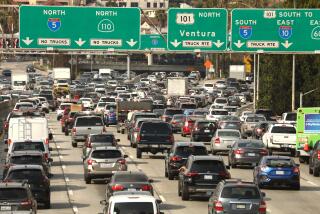Computers Blaze a Trail to High-Tech Road Design
- Share via
MINNEAPOLIS — Imagine speeding down Minnesota 61 along the North Shore in an Acura Legend, rushing to reach your vacation spot.
After passing a sign that says “Welcome to Tofte,” you look off to the right, where you see the Bluefin Bay resort. A sailboat drifts across the bay. Farther out on Lake Superior, an ore boat makes its way toward Duluth, 70 miles to the southwest.
Maybe you slow down to take a look. Or maybe you’re one of the many drivers who hits the gas and roars through town at 70 mph.
“People drive this highway like they’re absolutely crazed, and it’s just not built for it,” says Dave Carlson, a Tofte resident.
At whatever speed, you’re not really on the North Shore. You’re really on a “virtual highway,” in a driving simulator at the University of Minnesota, where researchers are using new techniques to design the highways of the future.
The Minnesota Department of Transportation is relying on this research as it rebuilds nearly 2 miles of Minnesota 61 that run through Tofte. Targeting fall 1999, the state agency wants to make the stretch safe for drivers and pedestrians.
To help the design, the agency has enlisted the aid of university experts who are using sophisticated computer techniques to test alternatives. Underneath the stands of a hockey arena, staffers at the Human Factors Research Laboratory have built a 3-D computer model of the highway.
The work involves much more than computer-aided design. Researchers can feed their model into the driving simulator to test how motorists react to various changes, so the agency can alter the plan.
Making changes to this “virtual highway” often takes only a few clicks with a mouse. Making similar changes to a real highway after it’s built could take years--and cost thousands, even millions, of dollars. This part of the project is costing the state less than $50,000.
“We can’t afford to go back,” says Pat Huston, an agency engineer in Duluth who is leading the project design. “We need to do the best we can the first time.”
One of their tests aims to determine whether drivers slow down if they get visual clues of their speed. To test that, Peter Hancock, the lab director, says designers can add road markings, crosswalks or clumps of trees and bushes beside the road, or try contrasting pavement colors for the shoulders.
In a few weeks, test drivers recruited from university students and staff will start driving eight alternative designs. The drivers, diverse but representative of driving demographics, are “typical enough,” assures Steve Scallen, the lab’s interim director.
Once selected, test drivers sit in an old Acura rebuilt to feed data into the computer. Then, as the car sits inside a dark, round, tent-like structure, a computer projects a 180-degree view of the road ahead--plus scenery--on a wraparound screen.
While other agencies throughout the country have wraparound driving simulators, Scallen says Minnesota’s may be unique in the way it allows researchers to collect data to test and compare alternative designs.
With more traffic along the North Shore, and the arrival of more vacationers, many locals agree that the highway needs to be safer. “The future is more traffic. You can see that coming,” says Mike Quaise, who owns a gas station in Tofte. “To plan for that only makes sense.”
More information on the Tofte project and other programs of the Human Factors Research Laboratory at the university’s School of Kinesiology is available on the Internet at https://hawk.psych.umn.edu.




